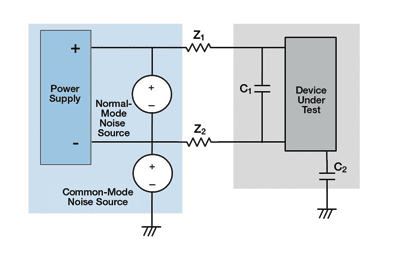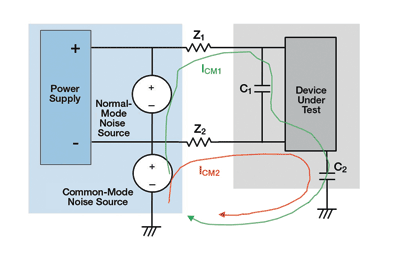Noise considerations for bench/ATE supply selection
Traditional beliefs about switch-mode and linear power supplies need to be re-evaluated in the light of today’s supply performance
BY BOB ZOLLO
Agilent Technologies
Budd Lake, NJ
http://www.agilent.com
From time to time, engineers struggle when choosing an instrumentation-grade power supply for bench testing or ATE systems. They ask themselves, “Should I choose a switch-mode power supply or a linear power supply?”
The struggle they have is due to the perceived attributes of the two different types of supplies. Switchers have advantages of high efficiency, small size, and low heat generation, while linear supplies tend to be larger and heavier. However, the key factor to consider when choosing between switchers and linears is electrical noise. The commonly held belief is that switchers are noisier that linears.
The need for less noise
For product evaluation and test, an instrumentation-grade power supply with little noise is often wanted. Instrumentation-grade switching power supplies have been around since the late 1970s. However, early designs suffered from issues with large amounts of electrical noise, which made them unsuitable for testing noise-sensitive devices. Thus linear supplies tended to dominate for test.
Over the years, switching power supply design has improved, but people’s impressions have not kept pace with the real state of the art in switching power supply design. This “once burned, twice shy” attitude may be perpetuated due to a limited understanding of the nature of electrical noise and how it can adversely affect the device under test (DUT).
One cause for concern about switching power supplies is that they typically operate (or switch) at 50 to 100 kHz. Electrical noise is generated at the switching frequency and its harmonics. In contrast, linear power supplies generate noise at line frequency (50 or 60 Hz) and its harmonics, resulting in a noise profile that is lower in frequency and easier to mitigate.
Types of noise
There are three types of noise to be considered: peak-to-peak and rms normal-mode noise, and common-mode noise. Normal-mode noise is defined as noise that appears on the positive output lead with respect to the negative output lead of the power supply, while common-mode noise is defined as noise that identically appears on both the positive and negative output lead with respect to ground (see Fig. 1 ).

Fig. 1. Both normal-mode and common-mode noise sources are found in a typical power supply setup.
For most supplies on the market today, only the rms normal-mode noise is specified. However, it is the peak-to-peak normal-mode noise and the common-mode noise that can be more troublesome. For many supplies, peak-to-peak normal-mode voltage noise can be 10 times higher than the rms noise. Furthermore, common-mode noise is quite misunderstood and, given that it is also rarely specified, it can be the culprit generating noise issues when trying to use switching power supplies.
For engineers, learning that their power supply can create noise at high frequencies immediately generates cause for alarm. However there is always inductance and capacitance encountered in typical wiring between the power supply output and the DUT. Therefore, the leads themselves tend to act as filters to high frequency noise. As a result, in 80% to 90% of the cases, high frequency noise does not matter as it never reaches the DUT due to the filtering effects of the wiring. However, that still leaves some 10% to 20% of the cases where noise does matter.
Since normal-mode noise appears as a difference between the positive and negative power supply lead, normal-mode noise is the noise that can negatively affect the DUT. Common-mode noise, since it appears equally on both leads, seems “invisible” to the DUT.
While common-mode noise does not impact the DUT like normal-mode noise, it should be noted that common-mode noise current does actually flow through the DUT and, once inside the DUT, could cause issues with radiation and crosstalk. In Fig. 2 , as common-mode noise currents ICM1 and ICM2 flow through the impedances Z1 and Z2 in each lead (see Fig. 2), a voltage drop occurs across the impedance, converting common-mode current noise to common-mode voltage noise.

Fig. 2. Common-mode current becomes normal-mode voltage through Z1 and Z2 . At high frequency, C1 and C2 look like short circuits, allowing ICM to flow.
As long as the impedance in both leads is nearly equal, then the voltage drop due to noise will be the same in each lead and so, again, the noise will be “invisible” at the DUT. However, if the impedance of each lead is different, then the voltage drop will be different in each lead. This difference in voltage drop per lead will result in a voltage difference between the positive in negative lead and will therefore appear as normal-mode voltage noise. Hence, common-mode current noise will be converted to normal-mode voltage noise due to lead impedance mismatch and thus the mysterious, unspecified, invisible common-mode noise becomes harmful, not to mention quite visible and measurable with a scope.
Selection criteria
Of course, there are still some applications, such as testing VCOs, PLLs, and pagers, where the DUT is extremely sensitive to noise. For these applications, a power supply with low 1/f noise (typically specified in nV/√Hz) is required because low-frequency noise can be a source for jitter in these applications. Linear power supplies win in these applications, as they have extremely low 1/f noise.
A typical switching power supply will have high common-mode current unless very careful attention is paid during the design of the power supply. Since common-mode noise is not typically specified, when selecting a switching power supply, you have no idea whether you are looking at a well-designed switching power supply with low common-mode noise or a simple switching power supply that has not been designed with any mitigation of common-mode noise. The accompanying table indicates basic performance characteristics and selection considerations.

When you are concerned about noise, selecting a low-noise supply is important. Common-mode current noise can be a hidden hazard. How do you know the supply you select is good enough, especially if common-mode current noise isn’t specified?
Power supply makers that achieve the highest level of performance will clearly specify common-mode noise current so users who are sensitive to noise will know that the power supply suits their application. Look for this specification to determine if a switching power supply is “state of the art.”
Why don’t all power supplies offer low common-mode noise? Designing for low common-mode noise is very challenging, and most power-supply designers do not have the special expertise and experience needed. Further, mitigating common-mode noise requires that addition of costly components that drive up the supply’s price.
For example, Agilent’s seventh generation of switching power supply architecture is based on 25+ years of experience in supply designs, resulting in common-mode current levels of just 3 mA. First, noise is reduced by controlling edges and spikes within the switching circuits. Next, multiple layers of patented common-mode filters are used to reduce harmonics; this approach prevents common-mode noise from leaving the power supply. In addition, normal-mode noise is also reduced by proprietary filter design. New technology in the next generation design will drop common-mode current noise down to the μA range. ■
Advertisement
Learn more about Agilent Technologies





